- LanguageAfrikaans Argentina Azərbaycanca
Bahasa Indonesia Brasil Brezhoneg
Català Česky Dansk
Deutsch Dhivehi English
English English Español
Esperanto Estonian Euskara
Finnish Français Français
Gaeilge Galego Hrvatski
Íslenska Italiano Latviešu
Lëtzebuergesch Lietuviu Magyar
Malay México Nederlands
Norsk bokmål Norwegian nynorsk Polski
Português Română Slovenšcina
Slovensky Srpski Svenska
Tiếng Việt Türkçe Wolof
Ελληνικά Български Македонски
Монгол Русский Српски
Українська עברית العربية (مصر)
العربية العربية پارسی
कोंकणी বাংলাગુજરાતી
தமிழ் ಕನ್ನಡ ภาษาไทย
ქართული ខ្មែរ 中文 (繁體)
中文 (香港) 日本語 简体中文
한국어
Home / Connoisseur's Corner / zeiss_6cm_3.5_tessar_1240000 38
In 1945 the occupying American forces took the fabulous Zeiss lens
collection from Jena to the United States. This was a unique collection of
historic Zeiss lenses, specially significant lenses by other manufacturers,
and, most importantly, a complete set of Zeiss prototype, sample and test
lenses, together with the accompanying documentation. The collection was
carefully kept for a time, having been studied by Kaprelian and Merté, but
in the 1960s it was sold off piecemeal through Burke and James and other
traders, and the surviving lenses now lie dispersed throughout numerous
collections, mainly in the United States. One collector who appears to have
bought a large number of these lenses was Burleigh Brooks, whose collection,
including a number of rare and significant prototypes which were almost
certainly part of the dispersed Zeiss lens collection. This lens came from that collection. 6cm f3.5 Tessar, like those made for the 4x4 Baby
Rolleflex, in a sunk barrel mount. According to the Zeiss production data
published by Hartmut Thiele (Fabrikationsbuch Photooptik Carl Zeiss Jena,
2003, p. 246), this lens (serial number 1240000) is a single specimen,
produced as a production run of one in February 1931. It is very likely that it was a test lens. Calculations for the 6cm f3.5 Tessar were concluded on August 21, 1930. One lens was produced on 26 August. In October two production runs, total 3000 lenses, were made for the Rolleiflex 4x4.
Then on February 10, 1931 this lens (nº 1240000) was produced as a single
specimen. As it is in a sunk barrel mount, it was presumably intended for
bench testing. Possibly as a result of these tests, the 6cm f3.5 Tessar was
recomputed in February 1931, and a further 7000 recomputed lenses (plus a
third â recomputed - test lens) were made in 1931-32 and issued with the
Rolleflex 4x4. This particular lens's production card is in card set nº 44,
which, as Thiele's documentation shows, was reserved for research, test and
sample lenses (marked Versuchs, Muster, or produced in runs of one, two or
three) made between 1930 and 1937.
It is M- condition, only very very faint coating spot on rear element.

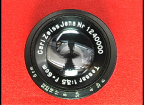 zeiss_6cm_3_5_tessar_1240000_1.jpeg
zeiss_6cm_3_5_tessar_1240000_1.jpeg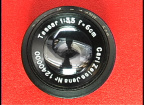 zeiss_6cm_3_5_tessar_1240000_2.jpeg
zeiss_6cm_3_5_tessar_1240000_2.jpeg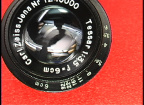 zeiss_6cm_3_5_tessar_1240000_3.jpeg
zeiss_6cm_3_5_tessar_1240000_3.jpeg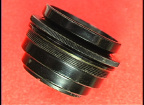 zeiss_6cm_3_5_tessar_1240000_4.jpeg
zeiss_6cm_3_5_tessar_1240000_4.jpeg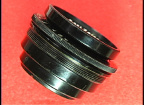 zeiss_6cm_3_5_tessar_1240000_5.jpeg
zeiss_6cm_3_5_tessar_1240000_5.jpeg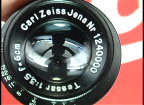 zeiss_6cm_3_5_tessar_1240000_6.jpeg
zeiss_6cm_3_5_tessar_1240000_6.jpeg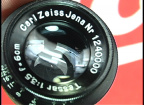 zeiss_6cm_3_5_tessar_1240000_7.jpeg
zeiss_6cm_3_5_tessar_1240000_7.jpeg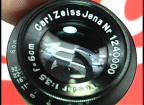 zeiss_6cm_3_5_tessar_1240000_8.jpeg
zeiss_6cm_3_5_tessar_1240000_8.jpeg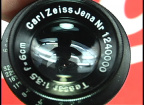 zeiss_6cm_3_5_tessar_1240000_9.jpeg
zeiss_6cm_3_5_tessar_1240000_9.jpeg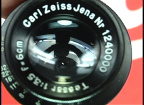 zeiss_6cm_3_5_tessar_1240000_10.jpeg
zeiss_6cm_3_5_tessar_1240000_10.jpeg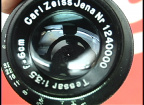 zeiss_6cm_3_5_tessar_1240000_11.jpeg
zeiss_6cm_3_5_tessar_1240000_11.jpeg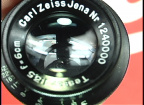 zeiss_6cm_3_5_tessar_1240000_12.jpeg
zeiss_6cm_3_5_tessar_1240000_12.jpeg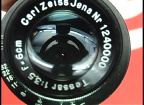 zeiss_6cm_3_5_tessar_1240000_13.jpeg
zeiss_6cm_3_5_tessar_1240000_13.jpeg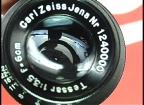 zeiss_6cm_3_5_tessar_1240000_14.jpeg
zeiss_6cm_3_5_tessar_1240000_14.jpeg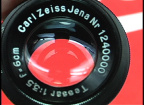 zeiss_6cm_3_5_tessar_1240000_15.jpeg
zeiss_6cm_3_5_tessar_1240000_15.jpeg